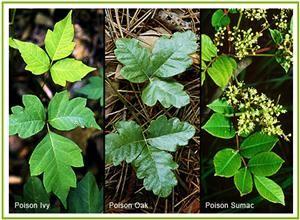
Everyone has grown up being warned to stay away from “leaves of three,” “berries white,” and “hairy vines.” These are the few ways we can spot poison ivy and poison oak while spending time outdoors. Thankfully there are a few distinct differences between the two.
There are many kinds of poisonous plants in nature, but the big three that often cause the most damage are poison oak, poison ivy, and poison sumac. These plants contain similar chemicals that can cause rashes when you come in contact with them. Urushiol is the substance that has ruined many summer vacations. It’s good to keep in mind that this is not a bacterium, so the rash can not spread once you’ve washed off the urushiol. However until it is washed off, this chemical can remain on your clothes and skin and spread to others by touch. You probably don’t realize how often you touch your face during the day or other objects. If you aren’t careful, you may end up making your rash far more widespread or spreading it to others who may have a severe reaction. Even a slight touch to the plants can result in a reaction.
The differences between poison ivy, poison oak and poison sumac:
Poison Oak:
Poison oak leaves resemble an oak leaf. They are a dull green and more distinctly toothed than poison ivy. Poison oak leaflets also have hairs on both sides, unlike poison ivy.
Poison Ivy:
Poison ivy has “hairy” vines and a viney growth pattern that resembles ivy. They are usually smooth or subtly toothed almond shaped leaflets that are sometimes irregularly lobed.
Poison Sumac:
Poison sumac is the most difficult to recognize of the “Big Three.” Why is that? To the untrained eye, it looks like a shrub or small tree. The leaves of this plant are arranged in pairs. Fortunately, this plant is confined to very wet areas, such as riverbanks. Unfortunately, compared to poison ivy and poison oak, this plant has a greater potential to inflict a more severe rash.
Poison ivy, sumac and poison oak are found in almost every state in the country. They grow at altitudes below 5,000ft and are deciduous bushes and vines. Neither stems have thorns. Both usually grow in groups of three ‘leaflets’ These can can range from the size of a thumb to a hand. The middle leaflet has a longer stem than the two side leaflets, this is more obvious in Poison Ivy than Poison Oak. Both also have white spring flowers which usually produce clusters of small white berries that become red in late summer.
Exposure to these plants will cause a rash for many. This rash sometimes become severe enough to develop additional symptoms such as fever, swelling, and blisters.Possible allergic reactions may also follow. In the most severe cases, people can develop an anaphylactic reaction. If this occurs, seek immediate medical care as this could be a life threatening situation. If yoIf you undergo any severe symptoms after coming in contact with poison oak or poison ivy, please seek medical care.
For more information contact us at AFC Urgent Care West Hartford, no appointment needed, 7 days a week from 8am-8pm weekdays, 8am-5pm weekends, at (860) 986-6440. You’ll be seen by our board-certified providers who will diagnose and treat your rash. You can also learn more about how best to protect your family from dangerous outdoor plants.


